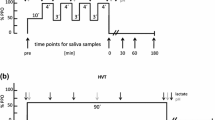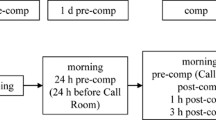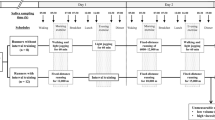Abstract
The aim of this study was to evaluate the effects of an official taekwondo competition (three 1-min rounds with a 1-min recovery in-between) on heart rate (HR), salivary alpha-amylase (sAA), and salivary-free cortisol (sC) in children. Parental consent was obtained for 12 young (10.4 ± 0.2 years) male taekwondo athletes. Saliva sample were collected 15 min before and 1 min after an official taekwondo competition, and at 30, 60, and 90 min of the recovery period. To evaluate the exercise intensity during the competition, HR was measured and expressed as a percentage of individuals HRpeak. Athletes spent 78% of the time working at HR > 90% HRmax, with significant increases from round 1 to round 2 and 3. Peak sAA observed at the end of the match (169.6 ± 47.0 U/mL) was different (P = 0.0001) from the other samplings (pre-competition 55.0 ± 14.0 U/mL, 30-min recovery 80.4 ± 17.7 U/mL, 60-min recovery 50.5 ± 7.6 U/ml; 90-min recovery 53.2 ± 9.6 U/mL). Peak sC values observed at 30-min recovery (17.9 ± 3.5 nmol/L) were different (P < 0.0001) from pre-competition (5.6 ± 0.9 nmol/L), post-competition (9.0 ± 2.0 nmol/L), 60-min recovery (10.3 ± 2.6 nmol/L) and 90-min recovery (4.2 ± 0.8 nmol/L) values. These findings confirm that taekwondo competitions pose a high stress on young athletes. The different sAA and sC reactions in response to the physical stressor mirror the faster reactivity of the sympathetic-adrenomedullary system relatively to the hypothalamic-pituitary-adrenocortical system, respectively. This experimental paradigm might represent a useful model for further research on the effects of various stressors (i.e., training and competition) in taekwondo athletes.


Similar content being viewed by others
References
Benitez-Sillero Jde D, Perez-Navero JL, Tasset I, Guillen-Del Castillo M, Gil-Campos M, Tunez I (2009) Influence of intense exercise on saliva glutathione in prepubescent and pubescent boys. Eur J Appl Physiol 106:181–186
Bot SDM, Hollander AP (2000) The relationship between heart rate and oxygen uptake during non-steady state exercise. Ergonomics 43:1578–1592
Bridge CA, Jones MA, Hitchen P, Sanchez X (2007) Heart rate responses to Taekwondo training in experienced practitioners. J Strength Cond Res 21:718–723
Bridge CA, Jones MA, Drust B (2009) Physiological responses and perceived exertion during international Taekwondo competition. Int J Sports Physiol Perform 4:485–493
Bunc V, Psotta R (2001) Physiological profile of very young soccer players. Int J Sports Med Phys Fitness 41:337–341
Butios S, Tasika N (2007) Changes in heart rate and blood lactate concentration as intensity parameters during simulated Taekwondo competition. J Sports Med Phys Fitness 47:179–185
Chiodo S, Tessitore A, Cortis C, Lupo C, Ammendolia A, Iona T, Capranica L (2011a) Effects of official Taekwondo competitions on all-out performances of elite athletes. J Strength Cond Res 25:334–339
Chiodo S, Tessitore A, Cortis C, Cibelli G, Lupo C, Ammendolia A, De Rosas M, Capranica L (2011b) Stress-related hormonal and psychological changes to official youth Taekwondo competitions. Scand J Med Sci Sports 21:111–119
Chiodo S, Tessitore A, Cortis C, Lupo C, Ammendolia A, Capranica L (2011c) Effects of official youth taekwondo competitions on jump and strength performances. Eur J Sports Sciences (in press)
Erie ZZ, Pieter W (2008) Physical fitness in recreational child taekwondo participants. In: Hume PA, Stewart AD (eds) Kinanthropometry In: XI Pre-Olympic Congress Anthropometry Research, 2008 Aug 1–5, Guangzhou, China, pp 90–95
Federazione Italiana Taekwondo (2009) Torneo Kim e Liù. http://www.taekwondowtf.it/circolari/circolare5-09. (Accessed 15 May 2009)
Granger DA, Kivlighan KT, el-Sheikh M, Gordis EB, Stroud LR (2007) Salivary alpha-amylase in biobehavioral research: recent developments and applications. Ann N Y Acad Sci 1098:122–144
Helsen WF, Bultynck JB (2004) Physical and perceptual-cognitive demands of top-class refereeing in association football. J Sports Sci 22:179–189
Hopkins WG (2010) A scale of magnitude for effect statistics. http://www.sportsci.org/resource/stats/effectmag.html. (Accessed 3 April 2010)
International Olympic Committee (2009) Olympic News: A “Go” for Youth Olympic Games. http://www.olympic.org/uk/news/olympic_news. (Accessed 28 July 2009)
Kim HB, Stebbins CL, Chai JH, Song JK (2011) Taekwondo training and fitness in female adolescents. J Sports Sci 29:133–138
Kirschbaum C, Hellhammer DH (1989) Salivary cortisol in psychophysiological research: an overview. Neuropsychobiol 22:150–169
Kivlighan KT, Granger DA (2006) Salivary a-amylase response to competition: relation to gender, previous experience, and attitudes. Psychoneuroendocrinology 31:703–714
Koh JO, Watkinson EJ, Yoon YJ (2004) Video analysis of head blows leading to concussion in competition Taekwondo. Brain Inj 18:1287–1296
Matsushigue KA, Hartmann K, Franchini E (2009) Taekwondo: physiological responses and match analysis. J Strength Cond Res 23:1112–1127
Nater UM, La Marca R, Florin L, Moses A, Langhans W, Koller MM, Ehlert U (2006) Stress-induced changes in human salivary alpha-amylase activity-associations with adrenergic activity. Psychoneuroendocrinology 31:49–58
Nater UM, Rohleder N, Schlotz W, Ehlert U, Kirschbaum C (2007) Determinants of the diurnal course of salivary alpha-amylase. Psychoneuroendocrinology 32:392–401
Pieter W (2008) Body build of elite junior taekwondo athletes. Acta Kinesiologiae Univ Tartuensis 13:99–106
Pieter W, Heijmans J (2000) Scientific coaching for Olympic Taekwondo, 2nd edn. Meyer & Meyer Sport, Oxford
Pilz-Burstein R, Ashkenazi Y, Yaakobovitz Y, Cohen Y, Zigel L, Nemet D, Shamash N, Eliakim A (2010) Hormonal response to Taekwondo fighting simulation in elite adolescent athletes. Eur J Appl Physiol 110:1283–1290
Rowland TW (1996) Developmental exercise physiology. Human Kinetics, Champaign
Skelton DL, Glynn MA, Berta SM (1991) Aggressive behavior as a function of Taekwondo ranking. Percept Mot Skills 72:179–182
Suzana MA, Pieter W (2006) The effect of training on general motor abilities in young Malaysian taekwondo athletes. Acta Kinesiologiae Univ Tartuensis 11:87–96
Suzana MA, Pieter W (2009) Motor ability profile of junior and senior taekwondo club athletes. Brazilian J Biomoricity 3:325–331
Toskovic NN, Blessing D, Williford HN (2002) The effect of experience and gender on cardiovascular and metabolic responses with dynamic tae kwon do exercise. J Strength Cond Res 16:278–285
van Stegeren A, Rohleder N, Everaerd W, Wolf OT (2006) Salivary alpha amylase activity as a marker for adrenergic activity during stress: effect of betablockade. Psychoneuroendocrinology 31:137–141
van Stegeren AH, Wolf OT, Kindt M (2008) Salivary alpha amylase and cortisol responses to different stress tasks: impact of sex. Int J Psychophysiol 69:33–40
Viru A, Viru M (2004) Cortisol-essential adaptation hormone in exercise. Int J Sports Med 25:461–464
Acknowledgments
The authors thank the taekwondo athletes who participated in this study, the General Secretary of the Italian Taekwondo Federation (FITA) Angelo Cito for his assistance in the organization of the experimental sessions, and Mario De Rosas, Erika Casolino and Antonio Ammendolia for their assistance in data processing. Funding from FITA and the University of Rome Foro Italico was received for this work.
Conflict of interest
None of the authors have no potential conflicts of interest.
Author information
Authors and Affiliations
Corresponding author
Additional information
Communicated by Susan A. Ward.
Rights and permissions
About this article
Cite this article
Capranica, L., Lupo, C., Cortis, C. et al. Salivary cortisol and alpha-amylase reactivity to taekwondo competition in children. Eur J Appl Physiol 112, 647–652 (2012). https://doi.org/10.1007/s00421-011-2023-z
Received:
Accepted:
Published:
Issue Date:
DOI: https://doi.org/10.1007/s00421-011-2023-z




